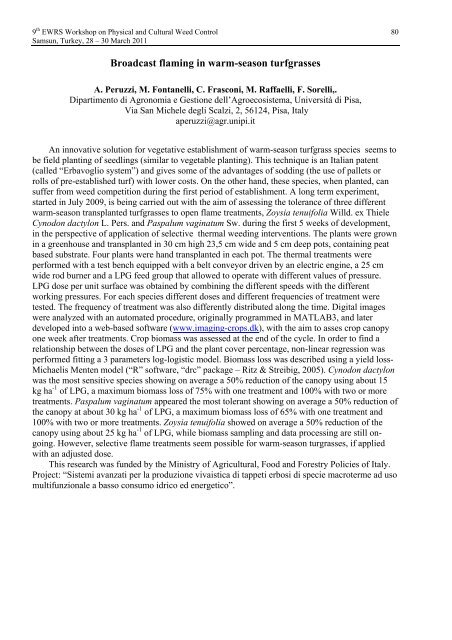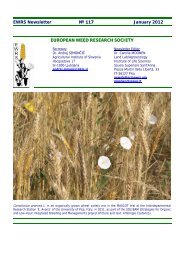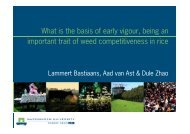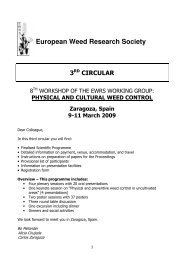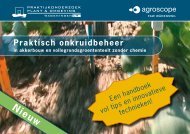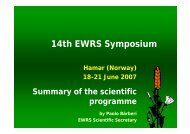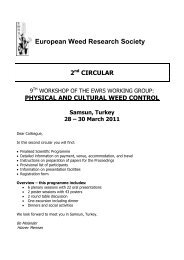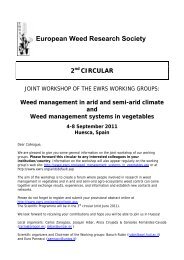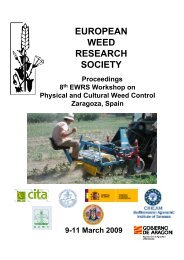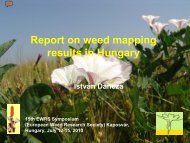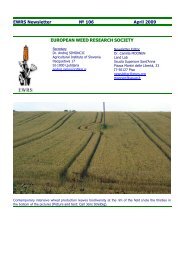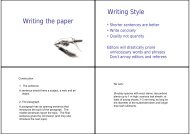Physical and Cultural Weed Control Working Group of - European ...
Physical and Cultural Weed Control Working Group of - European ...
Physical and Cultural Weed Control Working Group of - European ...
Create successful ePaper yourself
Turn your PDF publications into a flip-book with our unique Google optimized e-Paper software.
9 th EWRS Workshop on <strong>Physical</strong> <strong>and</strong> <strong>Cultural</strong> <strong>Weed</strong> <strong>Control</strong> 80<br />
Samsun, Turkey, 28 – 30 March 2011<br />
Broadcast flaming in warm-season turfgrasses<br />
A. Peruzzi, M. Fontanelli, C. Frasconi, M. Raffaelli, F. Sorelli,.<br />
Dipartimento di Agronomia e Gestione dell’Agroecosistema, Università di Pisa,<br />
Via San Michele degli Scalzi, 2, 56124, Pisa, Italy<br />
aperuzzi@agr.unipi.it<br />
An innovative solution for vegetative establishment <strong>of</strong> warm-season turfgrass species seems to<br />
be field planting <strong>of</strong> seedlings (similar to vegetable planting). This technique is an Italian patent<br />
(called “Erbavoglio system”) <strong>and</strong> gives some <strong>of</strong> the advantages <strong>of</strong> sodding (the use <strong>of</strong> pallets or<br />
rolls <strong>of</strong> pre-established turf) with lower costs. On the other h<strong>and</strong>, these species, when planted, can<br />
suffer from weed competition during the first period <strong>of</strong> establishment. A long term experiment,<br />
started in July 2009, is being carried out with the aim <strong>of</strong> assessing the tolerance <strong>of</strong> three different<br />
warm-season transplanted turfgrasses to open flame treatments, Zoysia tenuifolia Willd. ex Thiele<br />
Cynodon dactylon L. Pers. <strong>and</strong> Paspalum vaginatum Sw. during the first 5 weeks <strong>of</strong> development,<br />
in the perspective <strong>of</strong> application <strong>of</strong> selective thermal weeding interventions. The plants were grown<br />
in a greenhouse <strong>and</strong> transplanted in 30 cm high 23,5 cm wide <strong>and</strong> 5 cm deep pots, containing peat<br />
based substrate. Four plants were h<strong>and</strong> transplanted in each pot. The thermal treatments were<br />
performed with a test bench equipped with a belt conveyor driven by an electric engine, a 25 cm<br />
wide rod burner <strong>and</strong> a LPG feed group that allowed to operate with different values <strong>of</strong> pressure.<br />
LPG dose per unit surface was obtained by combining the different speeds with the different<br />
working pressures. For each species different doses <strong>and</strong> different frequencies <strong>of</strong> treatment were<br />
tested. The frequency <strong>of</strong> treatment was also differently distributed along the time. Digital images<br />
were analyzed with an automated procedure, originally programmed in MATLAB3, <strong>and</strong> later<br />
developed into a web-based s<strong>of</strong>tware (www.imaging-crops.dk), with the aim to asses crop canopy<br />
one week after treatments. Crop biomass was assessed at the end <strong>of</strong> the cycle. In order to find a<br />
relationship between the doses <strong>of</strong> LPG <strong>and</strong> the plant cover percentage, non-linear regression was<br />
performed fitting a 3 parameters log-logistic model. Biomass loss was described using a yield loss-<br />
Michaelis Menten model (“R” s<strong>of</strong>tware, “drc” package – Ritz & Streibig, 2005). Cynodon dactylon<br />
was the most sensitive species showing on average a 50% reduction <strong>of</strong> the canopy using about 15<br />
kg ha -1 <strong>of</strong> LPG, a maximum biomass loss <strong>of</strong> 75% with one treatment <strong>and</strong> 100% with two or more<br />
treatments. Paspalum vaginatum appeared the most tolerant showing on average a 50% reduction <strong>of</strong><br />
the canopy at about 30 kg ha -1 <strong>of</strong> LPG, a maximum biomass loss <strong>of</strong> 65% with one treatment <strong>and</strong><br />
100% with two or more treatments. Zoysia tenuifolia showed on average a 50% reduction <strong>of</strong> the<br />
canopy using about 25 kg ha -1 <strong>of</strong> LPG, while biomass sampling <strong>and</strong> data processing are still ongoing.<br />
However, selective flame treatments seem possible for warm-season turgrasses, if applied<br />
with an adjusted dose.<br />
This research was funded by the Ministry <strong>of</strong> Agricultural, Food <strong>and</strong> Forestry Policies <strong>of</strong> Italy.<br />
Project: “Sistemi avanzati per la produzione vivaistica di tappeti erbosi di specie macroterme ad uso<br />
multifunzionale a basso consumo idrico ed energetico”.


